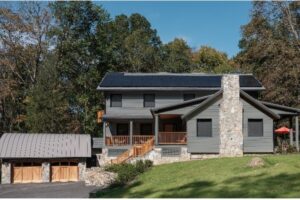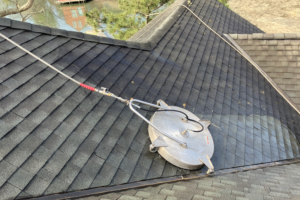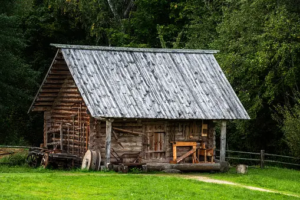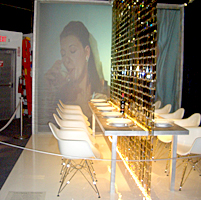 Why sacrifice style for sustainability? The Green Home Expo has run concurrently and practically shared space with The Architectural Digest Home Show at Pier 94 in NYC for the last couple of years. Isn’t it a hopeful sign of the changing times that the tree-huggers are now exhibiting side-by-side with ultra-luxe design?
Why sacrifice style for sustainability? The Green Home Expo has run concurrently and practically shared space with The Architectural Digest Home Show at Pier 94 in NYC for the last couple of years. Isn’t it a hopeful sign of the changing times that the tree-huggers are now exhibiting side-by-side with ultra-luxe design?
And, indeed, there seemed to be more than a little cross-fertilization going on between the two. Sustainability has definitely emerged as a player on the high-end market and vice versa. At the Green Expo not only did we sample high end organic chocolate harvested from free-trade nations only (delicious and guilt-free makes it taste even better) but we learned about sophisticated smart home technology that manages energy use in the home. On the Architectural Digest side, every furniture craftsman was careful to point out that the wood they used was either reclaimed or certified by the Forest Stewardship Council.
All Things Green
The Green Expo covered the waterfront on green solutions for life from cost-effective re-cycling of all your printer cartridges (www.cartridgeworldusa.com) to greening your outdoor space with low maintenance native plants (www.ecoearthdesign.com) to buying recyclable fabric gift wrap (www.shrapps.com). Since I naturally focus on the interior design categories, I was interested in the display of eco-friendly cabinetry and millwork shown to us by Theresa Kim. Her company is called Grain (www.buildgrain.com) and she was featuring some handsome bamboo kitchen cabinetry; she also works in sustainably harvested wood. Reassuringly, the cost is definitely in line with typical non-eco cabinetry and they are totally customizable. Recycled composite countertop samples were also available to complement your eco-cabinetry. Personally, I still prefer real stone and granite to the recycled stuff but I have to admit there is a lot more variety in color and style becoming available and the raw material can include such exotic re-purposed items as airplane runway lights (a real conversation starter for eco-maniacs).
Woodstock Organic Mattresses was exhibiting at the Green Expo but they weren’t sure if maybe the Architectural Digest Show would be a more appropriate venue; the mattresses are made out of organic cotton, eco-friendly wool and natural latex and they are comfortable and chemical-free – isn’t that a luxury item? (www.woodstockorganicmattress.com)
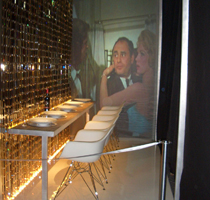 On the electronics front, a company called ThinkEco (www.thinkecoinc.com) offered a “modlet” that reduces user’s electricity bills by turning off power to appliances when they are not in use. It talks wirelessly to the home computer so users can see how much power their appliances consume; the company suggests that the modlet system pays for itself in six months. On the higher end of the electronics spectrum, the Electronics Design Group that was showing at Green Expo could have easily slipped into the luxury venue — they started out designing home theaters and over time have developed into a company that designs and installs complete building automation systems incorporating such green technologies as LED lighting, occupancy sensors, and automated window shades – all for the purpose of minimizing energy use. (www.edgonline.com)
On the electronics front, a company called ThinkEco (www.thinkecoinc.com) offered a “modlet” that reduces user’s electricity bills by turning off power to appliances when they are not in use. It talks wirelessly to the home computer so users can see how much power their appliances consume; the company suggests that the modlet system pays for itself in six months. On the higher end of the electronics spectrum, the Electronics Design Group that was showing at Green Expo could have easily slipped into the luxury venue — they started out designing home theaters and over time have developed into a company that designs and installs complete building automation systems incorporating such green technologies as LED lighting, occupancy sensors, and automated window shades – all for the purpose of minimizing energy use. (www.edgonline.com)
New Jersey Supports Green Technology
One thing seemed clear – the state of NJ is way ahead of NY in fostering the growth of green technology. A Company called Mercury Solar Systems promises to install solar panels on your roof for free; they own the panels and the energy generated but they give you the benefit of smaller utility bills – all due to the great tax advantages and solar credits offered by the State of New Jersey. New York is lagging behind in such renewable power incentives.
Green and Glamorous
On the Architectural Digest side, I noticed more than just a few furniture makers who were making rough-edge plank furniture from salvaged wood and fallen trees, which was popular back in the 1970’s. The concept is pretty similar but the finishes are much more sophisticated, and now the furniture has a universally streamlined aesthetic, where in the 70’s version the finishes tended to be rough or “natural.” Choosing a local craftsman is all the more eco-friendly; one such furniture maker that we spoke with is Joseph Nero. Located in Bedford, NY, he was exhibiting what he calls “Natural Form Furniture.” (www.crotonriverfurniture.com)
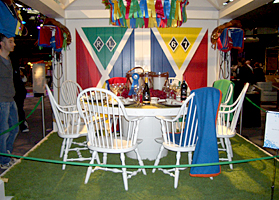 I suppose the case can be made that custom furniture by its very process is less wasteful than mass-produced furniture. A lot of cheap mass-produced furniture has a short useful life and, when it either breaks or goes out of fashion, it ends up in landfills, whereas custom furniture that is beautifully made for a specific purpose is much less likely to be discarded and is often handed down through generations.
I suppose the case can be made that custom furniture by its very process is less wasteful than mass-produced furniture. A lot of cheap mass-produced furniture has a short useful life and, when it either breaks or goes out of fashion, it ends up in landfills, whereas custom furniture that is beautifully made for a specific purpose is much less likely to be discarded and is often handed down through generations.
Reclamation Lumber of New Haven, Connecticut was proudly showing off beautiful examples of their reclaimed and refinished lumber. (www.reclamationlumber.com) They are calling it “mining the industrial forest” and it is a time-honored way to re-use, recycle and reduce waste in a particularly lovely way.
Finally, Fun for a Cause
I admit it, designers are definitely prone to being a tad sanctimonious when it comes to the benefits of design, green initiatives and related causes, but if there’s one thing designers love to do with no holds barred – it is to set up for a really great party. By far the most fun and over-the-top creative section of the Architectural Digest Show was the DIFFA fundraiser. DIFFA (Design Industries Foundation Fighting AIDS) was organized years ago to support the design community when it was particularly hard-hit during the AIDS epidemic in the US. Now their efforts reach around the globe. A number of sponsors and designers collaborated to create 50 Fabulous, Fantasy Dining Pavilions and, although it seems to me it might have been a challenge to actually eat at some of these creations (how does the thought of eating off leather dishes strike you?), there was a formal dinner served to benefit the charity.
The Benjamin Moore Paint pavilion took the prize for incorporating the most color; the surprisingly beautiful walls were papered in multi-hued paint chips. Designer David Rockwell’s booth was entirely knitted out of wool — no, really — the tablecloth, the walls, the seats, the napkins — it was like being in a huge sweater; I think the theme he was aiming for was “homespun comfort.” At the other extreme, DiSalvo Interiors swathed their booth in acres of bright red satin and black lace; the racy old-time Bordello atmosphere was humorously accented by a pair of black fishnet-clad legs peeking out from under the table. Ralph Lauren’s team produced an homage to the “horsey set” which looked like brunch at the barn complete with a chandelier composed of show ribbons.
My hands-down favorite booth however, was a designer tribute to vintage glitz. A shiny beaded curtain ran lengthwise down the center of a long rectangular table with lots of appropriate accoutrements, but the scene-stealer was a larger-than-life video featuring the party from “Breakfast at Tiffany’s” playing in an endless loop. There you were, dining with Holly Golightly at one of the greatest cinematic parties ever hosted; I found it irresistible.
Find photos of my other DIFFA favorites on my Blog, accessed thru my website. By the way, the DIFFA Dining by Design Show is traveling to major cities in the US — you might be able to catch it in Chicago or Boston. Cheers!
[blockquote class=blue]Barbara Sternau is an Interior Designer with offices at 4 South Washington Street Tarrytown, NY www.barbarasternau.com[/blockquote]


